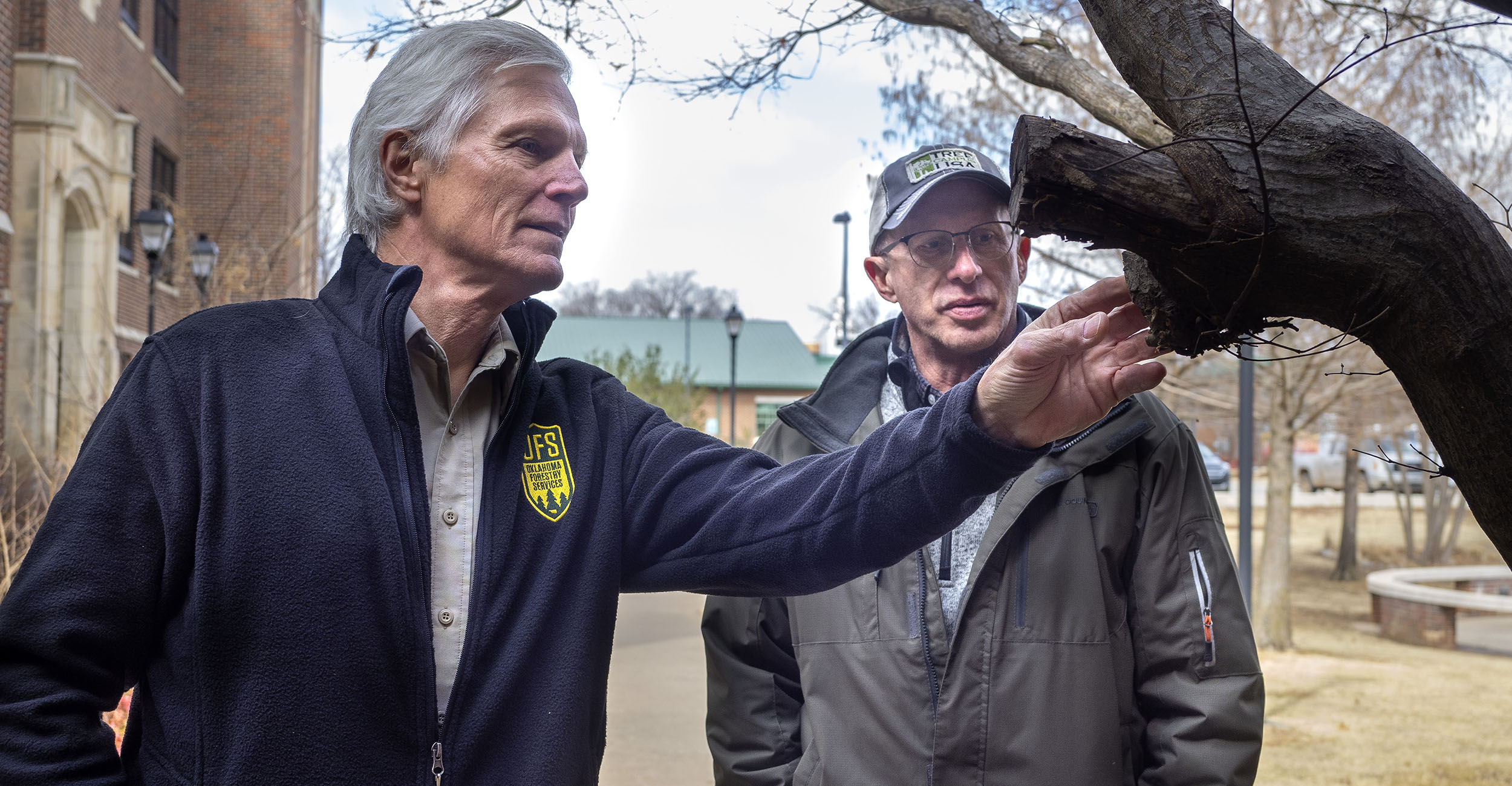
Celebrate Arbor Week in Oklahoma on March 20-26
Friday, March 18, 2022
Media Contact: Trisha Gedon | Communications Specialist | 405-744-3625 | trisha.gedon@okstate.edu
It was a walk down memory lane for Steve Dobbs and Mark Bays as the pair recently met at the Stillwater Public Library to check up on a tree project both were involved in 28 years ago.
The timing of the reunion was perfect as Oklahoma gears up to celebrate Arbor Week on March 20-26. While the rest of the country celebrates National Arbor Day in late April, Oklahoma pays homage to trees the last full week of March because it is the perfect time to get new trees in the ground.
Dobbs is currently a horticulture consultant with Facilities Management Landscape Services at Oklahoma State University, but 28 years ago he was host of OSU Agriculture’s television show, Oklahoma Gardening. Bays is the urban and community forestry coordinator with the Oklahoma Department of Agriculture, Food and Forestry.
“It was great coming back to Stillwater Public Library to see how the trees are doing that were purchased through a grant to the City of Stillwater from Oklahoma Forestry Services when the library was established,” Dobbs said. “The success of these trees is a good example of what proper planning, planting and care will do. It’s important to keep in mind the right tree in the right location.”
Bays said the landscape design at the Stillwater Public Library is successful due to the planning that took place nearly three decades ago.
“It’s great to come back and see the forethought they put into this design at the library has really paid off,” Bays said. “The trees have grown really well and certainly enhance the landscape. This is a good example of planting trees for the future.”
Dobbs also pointed out that the planning of the library landscape all those years ago played a role in the trees surviving several ice storms and the heat of summer.
“That’s what happens when you focus on proper planting,” Dobbs said. “The same factors that went into this project should be followed by homeowners when planning their own landscape.”
Some of the biggest mistakes homeowners make when planting trees are placing them too close to the house and other structures, planting near powerlines and improper planting.
Bays said a tree’s future success depends not only on choosing the right tree for the right location, but also on mulching, watering and the care required to become fully established.
“Oftentimes homeowners think all they need to do is dig a hole and put the tree in it, but it’s more than that,” Bays said. “Proper long-term maintenance will help ensure the tree is able to withstand everything that Oklahoma’s weather has to offer.”
Why are trees important to the landscape? Trees can improve the environment in urban and rural communities of all sizes.
“Trees are more than something for kids to climb. They also have great health benefits because they remove carbon dioxide from the atmosphere and reduce air pollution,” Bays said. “They filter ozone, nitrogen dioxide and sulfur dioxide from the air we breathe, and established trees can also add to the value of a person’s property.”
In addition to health benefits, tree roots hold soil in place, which reduces erosion, said Casey Hentges, host of Oklahoma Gardening and assistant specialist with OSU Extension.
“Erosion can cause a lot of problems in both home and commercial landscapes. Trees also intercept rainfall and lessen the amount of runoff into sewers, streams and rivers, which helps improve water quality,” Hentges said. “Trees can have an impact on your wallet because they provide protection to your home in the form of shade and wind blocks. This helps homeowners reduce heating and cooling costs.”
Trees also have a positive impact on human health. Research shows spending time around trees can reduce stress, lower blood pressure and improve mood, Bays said.
“There’s so much information online to learn about the health benefits of trees. Green spaces and tree-lined streets encourage walking and outdoor activities,” he said. “Kids who play outdoors are more relaxed and attentive, which helps with school performance. Trees really are so much more than an element in the landscape.”
Check out the Healthy Trees, Healthy Lives website for more information about the impact trees have on human health.
OSU Extension’s fact sheet HLA-6414 Planting Trees and Shrubs offers more information about planting trees and shrubs. Additional landscaping information is also available online.
